The History of Huntington Beach Surf Clubs
Originally Written by Bruce Gabrielson in 1991 Ten Year President
(1967-1977)
Huntington Beach Surfing Association
With added inputs from various individuals.
 As happens in modern times, surf clubs evolve from a group of surfers who travel
and surf together and eventually form close bonds with each other. Younger surfers
needed rides and older surfers had cars, plus there was an interest back then in
incouraging beginners and trying to get new surfers into the sport. Friendships were
easy to form and once formed, became strong influences in a surfers life. We didn't have
wetsuits and fires were allowed on the beach, so after spending time in cold
water you really had the chance to get to know those you surfed with. Also,
there weren't large numbers of surfers in the water back then and it didn't take
long to figure out who was a local at any particular beach you visited. Surf
clubs grew from local groups who surfed together at primarily one
spot on a regular basis.
As happens in modern times, surf clubs evolve from a group of surfers who travel
and surf together and eventually form close bonds with each other. Younger surfers
needed rides and older surfers had cars, plus there was an interest back then in
incouraging beginners and trying to get new surfers into the sport. Friendships were
easy to form and once formed, became strong influences in a surfers life. We didn't have
wetsuits and fires were allowed on the beach, so after spending time in cold
water you really had the chance to get to know those you surfed with. Also,
there weren't large numbers of surfers in the water back then and it didn't take
long to figure out who was a local at any particular beach you visited. Surf
clubs grew from local groups who surfed together at primarily one
spot on a regular basis.
The first club in the region was Long Beach Surf Club, formed in the 30s
primarily by surfers from Long Beach, Seal Beach, and Huntington. Long Beach
surfing started to taper off after the breakwater was built with many of the
surfing populace and much influence started shifting farther south.
In 1938 the City of Long Beach hosted the first National
Surfing and Paddleboard Championships, inviting surf clubs from California and Hawaii.
Long Beach Surfing Club was formed at that time and took part in this event. Preston
Peterson and Mary Ann Hawkins of the Del Mar Surfing Club won in the national paddleboard
division, but lack of heavy surf postponed the surfing competition until December.
In 1939, Long Beach again hosted the National Surfing and Paddleboard
Championships. The Hermosa Beach men nosed out the defending trophy holders of
Manhattan Beach by 10 points. Venice Surfing Club was third and Long Beach Surf Club,
fourth. Gene Smith, representing the Hawaiian Surfing Club competed alone against the
teams and finished fifth. Individual surfing honors went to Long Beach Surfing Club
members John Olsen who finished first, Alvin Bixler, second, and Bob Reinhardt, fourth.
Gene Smith of Hawaii came in third. At the start of WW II, these early clubs
mostly faded into obscurity.
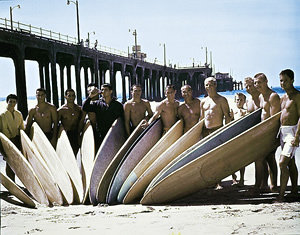
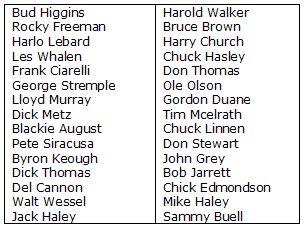 The first club in Huntington Beach was called Ko-Koi. It was founded in Hawaii in the early
1940s by Rocky Freeman and George Stemple, both of whom made boards and moved to Orange
County in the 1940s. They kept their boards under the pier. Newer members included Harlo
LeBard, Frank Serelli, Bud Higgins and Geordie Duane. Vince Morehouse, a lifeguard, got a
place to keep boards locked up and with Bob Bradley, Dean Ashbrook, Bob "Hammer Head" Gronisch,
Dick Metz, Joe Reddick, Dean "Man Mountain" Applegate, and Chuck Linnen, they became known as
the "Boys of 55."
The first club in Huntington Beach was called Ko-Koi. It was founded in Hawaii in the early
1940s by Rocky Freeman and George Stemple, both of whom made boards and moved to Orange
County in the 1940s. They kept their boards under the pier. Newer members included Harlo
LeBard, Frank Serelli, Bud Higgins and Geordie Duane. Vince Morehouse, a lifeguard, got a
place to keep boards locked up and with Bob Bradley, Dean Ashbrook, Bob "Hammer Head" Gronisch,
Dick Metz, Joe Reddick, Dean "Man Mountain" Applegate, and Chuck Linnen, they became known as
the "Boys of 55."
Gronisch was a lifeguard on 72nd Street in Longbeach and shaped boards at his home in the late
40s. He made an 11’ balsa gun for Ashbrook and took the board to Huntington Beach to have it
hristened. Dick Metz announced the christening. Ashbrook took the board out and immediately
hit the pier suffering numerous cuts.
By 1958 interest in surfing was again on the rise and one of the original members of the
1938 Long Beach club endeavored to renew the clubs vitality. Bob Reinhardt worked with
local surfers to grow a younger membership for the club. Several surfers were asked to compete for the club,
among those was Robert August.
By 1963 there was such a proliferation of Surfing Clubs amd competition intersst that the United States Surfing
Association was divided into districts. District 5’s boundaries extended from the
southern border of Palos Verdes Estates down to the northern border of Oceanside.
There were 23 registered clubs in District 5. The District directors were Robert Moore,
Mickey Munoz, Kit Horn, Hobie Alter and Tim Dorsey.
Along with the Long Beach Surf Club, there were eight clubs with Long Beach addresses:
Holo Kai, Makaui, North Long Beach Surfers, Poseidons, Southland Girls, West Shore
Surfers and Wipeouts.
 Other local clubs which were around in the early 60s included
B-5’s of Rossmoor-Los Alamitos, Bohemian Surfing Assoc., Seal Beach Surf Club,
Goat Hill Surfers of Newport Beach, San Onofre Surfing Club,
Salt Creek Surfing Society of Dana Point, Buena Park Surf Club,
Beachcombers of Orange-Santa Ana, Furr-Burr Surf Club of Sunset Beach,
Haggerty’s and Palos Verdes Surfing Clubs from Palos Verdes,
Seal Beach River Rats, Shorebreak Surfing Club and West Coast Surf Club of San Pedro,
Southern Shores of Anaheim, and Tritons. Out of the area was Haggerty's Surf Club and Wind and Sea.
Other local clubs which were around in the early 60s included
B-5’s of Rossmoor-Los Alamitos, Bohemian Surfing Assoc., Seal Beach Surf Club,
Goat Hill Surfers of Newport Beach, San Onofre Surfing Club,
Salt Creek Surfing Society of Dana Point, Buena Park Surf Club,
Beachcombers of Orange-Santa Ana, Furr-Burr Surf Club of Sunset Beach,
Haggerty’s and Palos Verdes Surfing Clubs from Palos Verdes,
Seal Beach River Rats, Shorebreak Surfing Club and West Coast Surf Club of San Pedro,
Southern Shores of Anaheim, and Tritons. Out of the area was Haggerty's Surf Club and Wind and Sea.
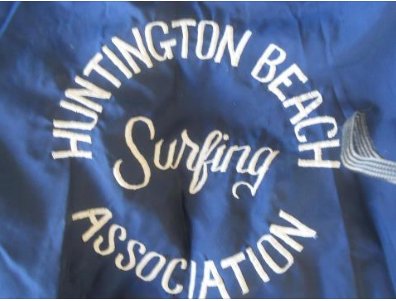 In the 1960's, there was sufficient interest in Huntington Beach
that four clubs evolved in the local area. The lifeguard sponsored
Huntington Beach Surf Club, primarily for pier oriented surfers, South Sea Surf Club,
a group of Huntington Cliffs surfers, a small loosely organized club called
Warner Street Surf Club at the foot of Warner Street, and the Huntington Beach
Surfing Association, a group of accomplished surfers that surfed around Huntington.
The long board picture shows a group of South Sea surfers at the cliffs in the fall of
1964 (I'm on the right in the pictures).
In the 1960's, there was sufficient interest in Huntington Beach
that four clubs evolved in the local area. The lifeguard sponsored
Huntington Beach Surf Club, primarily for pier oriented surfers, South Sea Surf Club,
a group of Huntington Cliffs surfers, a small loosely organized club called
Warner Street Surf Club at the foot of Warner Street, and the Huntington Beach
Surfing Association, a group of accomplished surfers that surfed around Huntington.
The long board picture shows a group of South Sea surfers at the cliffs in the fall of
1964 (I'm on the right in the pictures).
Clubs that emerged in other areas included Newport Beach Surfing Association,
Laguna Beach Surfing Association, San Clemente Surf Club, Point South
Surf Club, Bay Cities Surf Club (and Hermosa Beach Surfing Association
in the late 60's), Malibu Surf Club, Wind and Sea Surf Club, and
Menehune Ka Kai of Northridge also existed in other parts of Southern
California. The figure shows an award Bruce Gabrielson won in a meet between South Sea
Surf Club and Point South held at the HB Cliffs dated December 7, 1966.
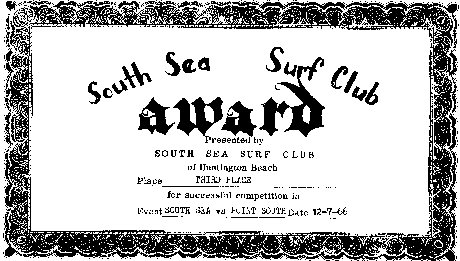
While some clubs basically were made up of people who all surfed in one area
and had no officers or meetings, several of the clubs were well organized with
dues and regular meetings. The clubs with dues or sponsors usually also had
jackets, T-shirts, patches, board and window decals, and other similar
identifiers. However, major changes took place beginning around 1966, both in
surfing and in individual thinking, which severely effected the established
surfing organizations.
Another problem for clubs was the mental attitude of the country during those years,
which also effected the surfing community. This was the time of
anti-establishment movements, anti-war demonstrations, and do your own thing.
College age surfers didn't want to be involved, or went away in the services,
leaving few to take over and coordinate the existing clubs. These conditions
created a situation within the surfing community where only the strongest clubs
could survive.
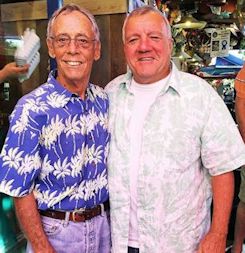 It's difficult to trace the exact origins of some early Huntington Beach surf clubs.
Huntington Beach Surfing Association was initially formed by a small group of high school
surfers in 1960 that met under the pier on weekends and wore brown T-shirts. It only
lasted a couple of years and then folded up. Max Klepfer and several area surfers
re-formed the club around 1964. The meetings were held at Max Klepfer's Surfboards Surfside
shop and sometimes at Kanvas by Katins. The first members included Robbie Koogan and
Lee Walsh from Huntington Beach, Steve Cleet, Bob Montgomery, Donnie and Howard Kurt, and
Randy Godfrey from Paramount, Chuck McElvin from Fullerton, Mike Bean and Jim Galagher from
Compton and Bob Holden from Los Alamitos. Others that became members soon after included
the Hawk brothers, Eddie Rothman, Robby Busie, Sonny (Weird Harold) Owens, Leroy Dennis, Pete Kobzev, Bob Leonardo,
Bruce Gabrielson, Jim Angley, Barry Church, and Sam Dusatko. Max was the first
president. Nancy Katin of Kanvis by Katin embroidered jackets and supplied trunks for club
members at a discount. In the picture at left Max is on the left and Bruce Gabrielson, the person
who followed MAx as HBSAs only other president.
It's difficult to trace the exact origins of some early Huntington Beach surf clubs.
Huntington Beach Surfing Association was initially formed by a small group of high school
surfers in 1960 that met under the pier on weekends and wore brown T-shirts. It only
lasted a couple of years and then folded up. Max Klepfer and several area surfers
re-formed the club around 1964. The meetings were held at Max Klepfer's Surfboards Surfside
shop and sometimes at Kanvas by Katins. The first members included Robbie Koogan and
Lee Walsh from Huntington Beach, Steve Cleet, Bob Montgomery, Donnie and Howard Kurt, and
Randy Godfrey from Paramount, Chuck McElvin from Fullerton, Mike Bean and Jim Galagher from
Compton and Bob Holden from Los Alamitos. Others that became members soon after included
the Hawk brothers, Eddie Rothman, Robby Busie, Sonny (Weird Harold) Owens, Leroy Dennis, Pete Kobzev, Bob Leonardo,
Bruce Gabrielson, Jim Angley, Barry Church, and Sam Dusatko. Max was the first
president. Nancy Katin of Kanvis by Katin embroidered jackets and supplied trunks for club
members at a discount. In the picture at left Max is on the left and Bruce Gabrielson, the person
who followed MAx as HBSAs only other president.
The Huntington Beach Surf Club, sponsored by the Huntington Beach Life Guards,
was established in July of 1963. It had approximately 70+ members initially joining the club.
The first elected officers were: Fred Eck, President; Jess Foss, Sergeant At Arms;
Jon Overmyer, Vice-President and Randy Hankins, Secretary-Treasurer. The city of H.B.
was concerned about certain negative social trends and initiated the
idea of a city sponsored surfing club. The idea was to "preserve the
sport of surfing and build athletes instead of bums." The Huntington
Beach News carried an article about the clubs formation on August 8, 1963.
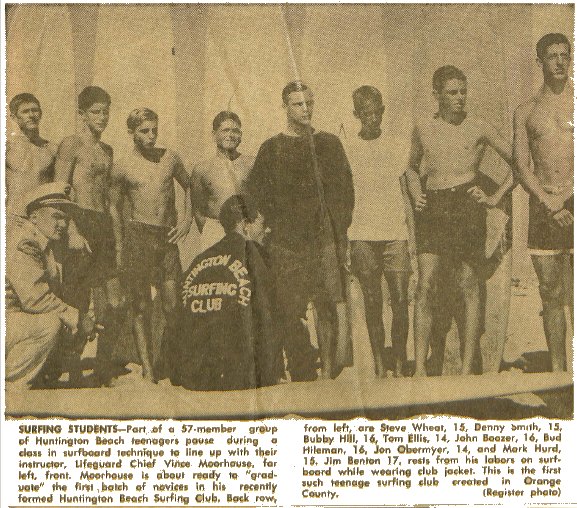
In the same edition, in the "Street Scene" section of the paper is reads: "The back cover of the July 'Surfing Guide'
magazine featuring the entire back page with a style plate picture taken at the Huntington Beach pier of male models.
Don Shusta, Richard Scott, Steve Harrington and Jess Foss...Inside photos of pier surfers in action included...Rich
Chew, John Peck, Roy Crump, Jim Richards, Denny Buell, et al." Most of these surfers,
too, were part of the club.

As time progressed some officers moved onto school, etc. and changes were made in the club. Jess Foss became
vice president...later president. Jim McKay moved into a leadership position...as did Mike Patrick.
Warner Street Surf Club was formed about 1963 or 1964, primarily for those who surfed Bolsa
Chica and Surfside. The club didn't have many members but did draw a few of the big
names from the Pier on a regular basis.
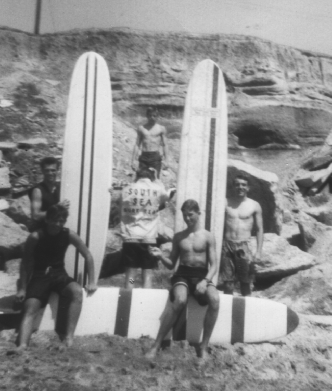 South Sea Surf Club (left) was formed in the spring of 1965 by a group of surfers that met each week and during the
summer months about midway between Golden West Street and Bolsa Chica along the cliff area. Not all the
members lived in Huntington Beach, with several living in Westminster. The club was only ablut 25 strong, but it was
very organized with regular meetings and organized meets. Some of the early members included Bruce Gabrielson,
Steve Booth, and Dave Guiltner. A few of the early members also belonged to other local clubs.
South Sea Surf Club (left) was formed in the spring of 1965 by a group of surfers that met each week and during the
summer months about midway between Golden West Street and Bolsa Chica along the cliff area. Not all the
members lived in Huntington Beach, with several living in Westminster. The club was only ablut 25 strong, but it was
very organized with regular meetings and organized meets. Some of the early members included Bruce Gabrielson,
Steve Booth, and Dave Guiltner. A few of the early members also belonged to other local clubs.
About 1966 Bruce Gabrielson joined HBSA to participate in an
unofficial contest and a keg party between Newport Beach Surfing Association and HBSA.
The party got a little wild and basically we wrote the place off. A story got into the
paper about the club being made up of bad guys, and at that time it was
invited to never have a contest again at the Pier. Nothing lasts forever
except the surf in Surf City. HBSA didn't fold but its members did start
keeping a low profile.
Besides bad press, another impact on clubs during the late 1960s had to
do with board evolution. With the coming of shorter boards,
a great many of the older, more organized individuals who kept the surf
clubs together simply refused to transition.
Also, young hot-shot surfers could not identify with most of these older
surfers, and thus refused to get involved with
many existing clubs.
The Re-Formation of HBSA
By 1967 in Huntington Beach, HBSC was toning down with most of the older
surfers going away to college or, like Jim Angeley, being drafted, and
only a few of the early members still sticking together. South Sea was
down to about twelve members, and Warner Street, except for Raul Duarte
and maybe Robert August, was pretty well gone. With interest in clubs
falling, a handful of area surfers decided to see if something could be
done to save the club structure.
Since Bruce Gabrielson was a member of HBSA and also president of South
Sea, he contacted nearly every member of all the clubs still active and
got them to attend a formal HBSA meeting at Max's place. The purpose
was to locate all past members left and still interested in clubs, and
then decide what to do about the remaining organizations.
There was a lot of discussion and an overall general concern that
something had to be done if local clubs were to survive.
From this meeting, one club, Huntington Beach Surfing Association
emerged as the one primary club for all Huntington Beach. All surfers,
the older surfers who had made the short board transition, young
hot-shots, and long boarders, both past and current members were welcome
at meetings. In the end, Bruce ended up as president of the new reorganized
association of local clubs. Following the meeting he was given all existing HBSA
records in a cardboard box from the secretaries, much of which still
exists. Bruce’s one major responsibility as the newly elected president
was the task of building HBSA back into a major
local force.
Nearly every top surfer in the region joined or returned to the club by
mid-summer. David Nuuhiwa, one of the top surfers in the world at that
time, and also a HBSA member, led the list to super stars. Regular meetings and
contests were held, new members were voted into the club, social activities were
hosted, and the club competed as a group in most major events throughout
the late 60's until about 1976.
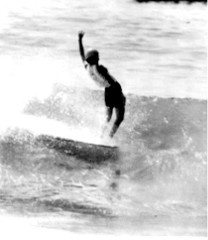
David
Nuuhiwa
Not only were most of the local surfers members of the club, but a large
number of outsiders also supported or joined the club. Surprisingly, at least
six South Bay surfers were very active, seldom missing a club championship or
other club event. Rusty Johnston, Dana Kimbrow, Tim Wirick, Bernie Keech, and
Jack Sahakian were actual club members.
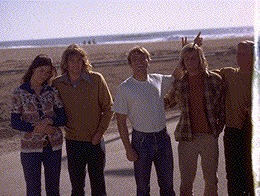
Tim Wirick, A
Friend, Myself, Lonnie Buhn, and John Van Ornum
During a Break in One of the
Two HB vs Menehune Ka Kai Challenge Competitions
(this one at Hollywood by
the Sea in 1972)
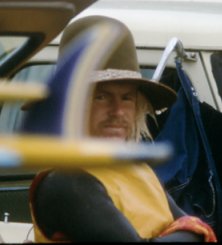
Mike Purpus (left), while never becoming an official member, entered five of
the six club championships held by HBSA. After reviewing heat sheets for these
events, it turns out only four members besides Mike entered this many club
championship events.
Another funny story about Mike should be told. Mike was/is a great surfer and
also a fun person. Knowing we had a habit of announcing club standings on a
regular basis at our championships, one year Mike entered a club called Charley
and the Horny Cougars. Every time we announced his club the spectators and
surfers on the beach roared their approval.
The real heyday of surf clubs came around 1970 or 71. Most every recognized
surfer in not only Huntington Beach but throughout Southern California was a
member of one club or another. Some of the clubs around by then included Brooks
St Surf Club, 17th St Ducks, Offshore (Oceanside), Suncraft, and the
Californian. San Fernando Valley Surf Club was big about 1972.
 HBSA was the dominant
club in Southern California during this era. At one time it had won 35 straight
club events, taking on virtually anyone who wanted to compete, either in open
contests or one-on-one, and at their home site or any other location. The
picture on the right shows me running one such club contest on the south side of
the Pier. The attached newspaper article is typical of HBSA dominance in the
club challenge events of the time.
HBSA was the dominant
club in Southern California during this era. At one time it had won 35 straight
club events, taking on virtually anyone who wanted to compete, either in open
contests or one-on-one, and at their home site or any other location. The
picture on the right shows me running one such club contest on the south side of
the Pier. The attached newspaper article is typical of HBSA dominance in the
club challenge events of the time.
Organized contests also recognized the importance of surf clubs during this
era, with most WSA contests offering both surf club and manufacturer's surf team
awards. Even international surf contests got into the club events. A small HBSA
group went to the International Surf Festival at Makaha around 1972, with two
members, Jeff Smith and myself reaching quarter final rounds and one member,
Laroy Dennis, reaching the semi- finals. The club finished third overall with
this effort.
The club also took several "surfing safaris" to Mexico and other great
locations. Among the trips were Santa Cruz (the party at Pat O'Neal's place),
Santa Barbara (remember the girl's dorm), Hollywood by the Sea (can't mention
that one), Malibu (George Segetti and company), K39 (remember the locals), and
3Ms. San Miguel held an annual club contest which, until HBSA showed up, was
almost always won by Encinada Surf Club. The HBSA/ESC competition created so
much friction, that a challenge match, one on one, was held at 3-M Beach about
1972 or 73. A number of club members who were also members of Huntington Beach
High School's first varsity surf team went on this trip, and those who were there will
never forget it, especially our fireworks display and "bombardment" of the other
surfers (remember the perfect tent shot) plus the other activities that went on
in town. We also got to enjoy a wind-up tent that didn't during that trip.
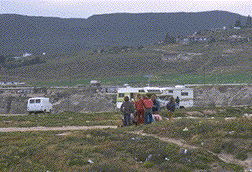
Part of the
Crew at 3Ms
HBSA dominated the meet, much to the consternation of the locals who managed
to get all US surfers barred from surfing at the Cannery shortly thereafter. Bruce
also personally got into a lot of hot water from Huntington Beach High School
officials as a result of this trip.

Left During the 3M
Contest
One year the members decided we needed club shirts, jackets and decals for
our boards. After several designs were evaluated, Robert "Sniffer" Milfield, a
local member and artist, designed and hand cut a silk screen for the club.
Featuring the pier at sunset, the design embodied the real sense of pride the
membership had in our club. The screen still exists and has been donated to the
International Surfing Museum in Huntington. Many members used this screen over
the years.
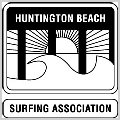 Another screen featuring
the letters HBSA in script was also cut by Robert, and has recently been used by
this author on shirts for some of the old time members.
Another screen featuring
the letters HBSA in script was also cut by Robert, and has recently been used by
this author on shirts for some of the old time members.
A HBSA club flag (see below) was also designed and put up on the beach
whenever a club or open competition was held and the team was competing. It was
about 3 feet by 4 feet, with a white background and green lettering. The banner
disappeared during a contest, some say taken by a rival club, about 1972 or 73.
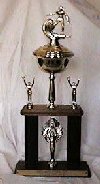
Another club activity was presentation of the semi- annual
Harris Kawata Memorial Award to the Outstanding HBSA Surfer. Harris Kawata was
an active and popular surfer in the club who was killed in an automobile accident.
This award, won by several of
the top surfers in the area, was presented to the club surfer who during the
previous six months had the most contest points gained through club and open
competitions. The club championships was a mandatory event for members going for
the award. Winning the award twice in succession retired the trophy. The trophy
was retired after the last club championship about 1975 by myself. Randy Weeden
and I had tied for first at the club championship, but I had more overall
points.
HBSA's annual Club Championships, open to all surfers, drew many of surfing's
top names. The first club championship was held just to see if we could hold one
in 1969. The first real organized official club championship was held the next
year in 1970. The last big contest was held in 1975. A semi-final heat in 1971
contained David Nuuhiwa, Laroy Dennis, Leigh Martin, and Mike Wilson. The other
semi-final heat featured Mike Purpus, Tim Wirick, John Van Ornum, and Randy
Lewis, all top-notch competitors. Randy Lewis won the contest.
In the junior division finals at that contest, Neils Osborne, David Van
Druff, Lonnie Buhn, and Tim Whelan had a real shoot-out. The Open Women event
featured Linda Bennish, Jan Gafney, Judi Monroe, and Mary Setterholm. These
represented many of the top surfers anywhere in the U.S. back then. I have
included an article about this event with this narration.
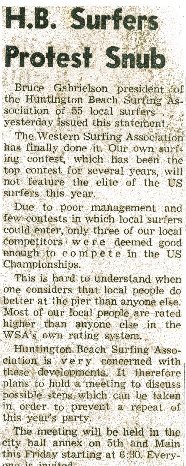 HBSA was also a major political force shaping the destiny of big surfing
events of the day, including the US Surfboard Championships held at Huntington
Beach Pier. In 1970, a serious controversy regarding eligibility and local entry
into the US Championships took place. Despite the high rankings of a number of
locals, a regional quota was established, and only three resident Huntington
Beach surfers, including myself, David Nuuhiwa, and Randy Lewis were invited to
participate in mens events. Chris Catell was in the Air Force rather then being
listed as a Huntington Beach resident, so was also invited. There may have been
one or two others, but I only had a newspaper article and my own memory, not an
official program, to research this subject.
HBSA was also a major political force shaping the destiny of big surfing
events of the day, including the US Surfboard Championships held at Huntington
Beach Pier. In 1970, a serious controversy regarding eligibility and local entry
into the US Championships took place. Despite the high rankings of a number of
locals, a regional quota was established, and only three resident Huntington
Beach surfers, including myself, David Nuuhiwa, and Randy Lewis were invited to
participate in mens events. Chris Catell was in the Air Force rather then being
listed as a Huntington Beach resident, so was also invited. There may have been
one or two others, but I only had a newspaper article and my own memory, not an
official program, to research this subject.
Outraged by this lack of regard for local talent, and reflecting views by
those left out from other regions, the club, 55 members strong by then, held a
meeting during the contest attended by nearly every top surfer in the world. Two
letters were written at the meeting, one to Hoppy Swarts, Regional WSA
Competition Director, and one to the City of Huntington Beach. Many in the
surfing world consider this action Surfing's "Declaration of Independence".
As a result of the meeting and protest, the United States Surfing Association
modified its rules to allow the top 2 place winners in each division from a
local Huntington Beach contest to receive bids into the championships, plus
modified other quota participation rules. The annual Huntington Beach Residents
Contest, first held August 21, 1971, was the direct result of this action. Since
I was responsible for the contest's creation, I was charged with running the
event, which subsequently grew into a very popular local contest.
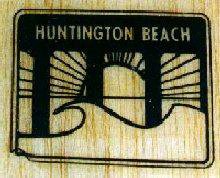 Towards the mid to late-1970's, many surf clubs had left the scene.
Several factors contributed to their demise. As boards and equipment grew more
expensive, manufacturer surf teams and board sponsorship became more important
then club activities to surfers. As such, competitors were too involved with
their sponsor to compete for other teams. Another factor was the rise of
organized college and high school competition teams. A surfer only has so much
organizational time he can devote to the sport.
Towards the mid to late-1970's, many surf clubs had left the scene.
Several factors contributed to their demise. As boards and equipment grew more
expensive, manufacturer surf teams and board sponsorship became more important
then club activities to surfers. As such, competitors were too involved with
their sponsor to compete for other teams. Another factor was the rise of
organized college and high school competition teams. A surfer only has so much
organizational time he can devote to the sport.
A third factor was costs, both for awards and for contest insurance. Dues
simply could not cover expenses. Insurance for a club event was very expensive,
and the City of Huntington Beach, like other municipal organizations, was simply
unwilling to issue a beach permit unless insurance was available. Insurance for
a club contest ran around $150 per day minimum. Without the contest as a primary
source of revenue for operation and awards, clubs simply could not afford
compete with other more sponsored activities.
 The last big contest held
by HBSA drew 126 entries and was held was during the spring of 1975. It was held
at the foot of Golden West Street, and was judged by Chuck Linnen and Jerico
Poppler, both HBSA members. Surfing was difficult with many heats being delayed
because of the super calm inconsistent beach break surf. I won masters division,
Mike Purpus won the open event, David Van Druff won juniors, and tiny Rusty
Johnston won the boys event.
The last big contest held
by HBSA drew 126 entries and was held was during the spring of 1975. It was held
at the foot of Golden West Street, and was judged by Chuck Linnen and Jerico
Poppler, both HBSA members. Surfing was difficult with many heats being delayed
because of the super calm inconsistent beach break surf. I won masters division,
Mike Purpus won the open event, David Van Druff won juniors, and tiny Rusty
Johnston won the boys event.
Since so few surfers were still present, and since the weather was hot and
accommodating with almost no wind, the club decided to hold one long super heat
with each of the division winners competing against each other. With small beach
break surf, riding a long wave or maneuvering much was very difficult. Rusty
Johnston, who couldn't have weighed more then 65 lbs, was perfect for the head
(his head) high waves. He dazzled everyone watching with countless maneuvers and
tricks, easily winning both the heat, and the Harris Kawata Memorial Trophy in
the process. Mike, who lived about one block from Rusty in Hermosa, wasn't happy
about the results, particularly since he had to be around Rusty on a regular
basis.
Around the spring of 1976, HBSA tried to organize one last club
championships. Only 46 surfers entered the meet, held at the foot of 23rd
Street. The surf was about 4 feet, rough and inconsistent, causing long heat
delays and poor scores. By afternoon the wind was bad and the surf had come up
only slightly, making conditions extremely difficult. Winners of each age group
included Randy Weeden in Open, Bruce Gabrielson in Masters, and Jeff Smith in juniors.
Randy and Bruce subsequently surfed to a dead even score in the overall after about
30 minutes in the water. Everyone wanted to go home so we flipped a coin and Bruce won.

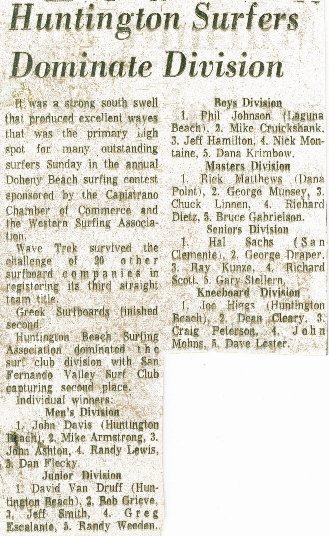
The last social event widely attended by HBSA was in the spring of 1976 when Bruce married Kim Way,
daughter of Huntington's Beach Director, Jim Way. Most of the young and old HBSA crew attended either the
wedding at the 10th Street Church, or the reception afterwards. I was still president of the club, close to eleven
years worth, and had notified everyone that I could no longer serve in that capacity. Although Bruce was still a
member and able to attend most events, particularly as a contest judge, this event was pretty much the end of his
HBSA organizational participation.
The club held a few meetings after Bruce retired as president a few months later and voted in new officers, but was
nearly defunct regarding large active participation. Only a few club activities were held by then, mostly in conjunction
with other events. The club officially folded in early 1979 with several members continuing to compete as the
Hole in the Wall Gang.
There have been four HBSA reunions since the club folded, each held at the Huntington Beach International Surfing Museum.
While mostly focused on HBSA members, many members from the other local clubs of the era regularly attend.
The first of these reunions
was held October 14, 2000. Not only did a large number of locals attend, but a number of members who live in
other parts of the world also attended. One of the best things that happened was that each member was given a chance
to tell the memories and stories, and these were all recorded for posterity. Below are two pictures from the first reunion.
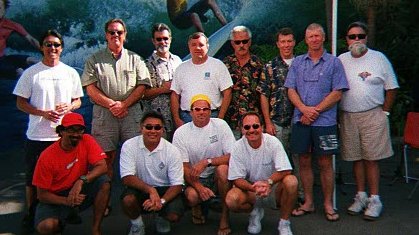
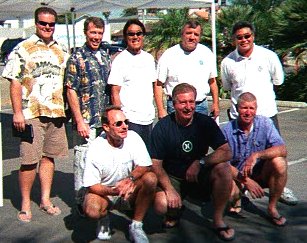
The 40th gathering was at the International Surfing Museum. The original HBSA T-shirt was re-released there.
Several of the original founders showed up
for the event. The picture below is a group at the event.
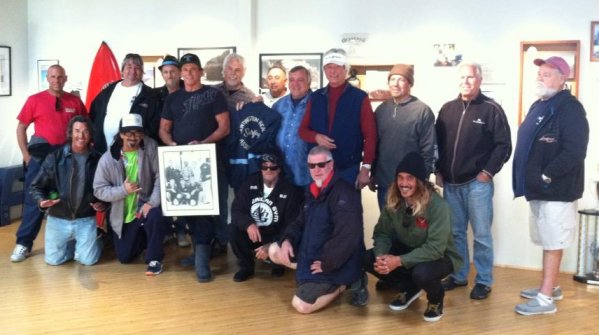
The 50th anniversary reunion was held at the El Ranchito Mexican restaurant in September 2016. Sal Avila owns
the restaurant and it was also the 50th anniversary of the restaurant chain, originally in Huntington Beach.
The next set of pictures are from the gathering.
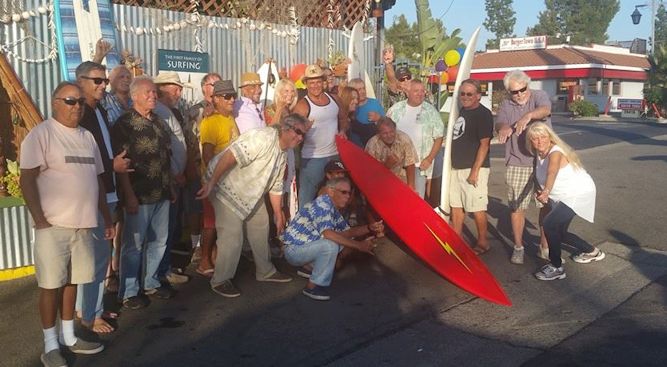

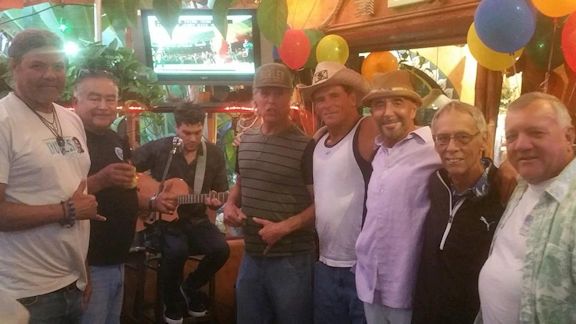
The Huntington Beach Longboard Crew
The Huntington Beach Long Board Crew emerged in November
of 1984 to offer a venue for those locals who liked club involvement.
Charter members of the HBLC included Mike Minchinton, Wally Walczyk, Gary Sahagen, Jacob
Sahagen, Joe Yeno, Nick Lopez, Dan Casey, Frank Cochran, John English, Lee Nesmith, Chris
Campen and Bob Asperin. In 2000, the club incorporated as a non-profit organization holding
monthly meetings and team competitions as a member of the Coalition of Surf Clubs (CSC).
The HBLC meets each month at Mario’s in Five Points Shopping Center, runs regular contests and
holds fund raisers for the Huntington Beach International Surfing Museum and many other
charitable organizations.
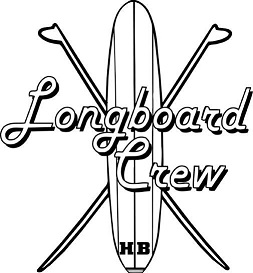
The re-emergence of club surfing corresponds the to organization of the
Coalition of Surf Clubs, an international organization that represents the interests of
surfing clubs throughout California and the world. In addition to offering a competitive
venue for club surfing, this organization acts as a united voice to address issues related
to coastal water quality, beach access, development, and legislative policy. The Coalition
currently represents over 20,000 surfers of all ages. The HBLC is a member of CSC.
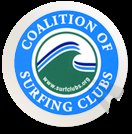
 As happens in modern times, surf clubs evolve from a group of surfers who travel
and surf together and eventually form close bonds with each other. Younger surfers
needed rides and older surfers had cars, plus there was an interest back then in
incouraging beginners and trying to get new surfers into the sport. Friendships were
easy to form and once formed, became strong influences in a surfers life. We didn't have
wetsuits and fires were allowed on the beach, so after spending time in cold
water you really had the chance to get to know those you surfed with. Also,
there weren't large numbers of surfers in the water back then and it didn't take
long to figure out who was a local at any particular beach you visited. Surf
clubs grew from local groups who surfed together at primarily one
spot on a regular basis.
As happens in modern times, surf clubs evolve from a group of surfers who travel
and surf together and eventually form close bonds with each other. Younger surfers
needed rides and older surfers had cars, plus there was an interest back then in
incouraging beginners and trying to get new surfers into the sport. Friendships were
easy to form and once formed, became strong influences in a surfers life. We didn't have
wetsuits and fires were allowed on the beach, so after spending time in cold
water you really had the chance to get to know those you surfed with. Also,
there weren't large numbers of surfers in the water back then and it didn't take
long to figure out who was a local at any particular beach you visited. Surf
clubs grew from local groups who surfed together at primarily one
spot on a regular basis.

 The first club in Huntington Beach was called Ko-Koi. It was founded in Hawaii in the early
1940s by Rocky Freeman and George Stemple, both of whom made boards and moved to Orange
County in the 1940s. They kept their boards under the pier. Newer members included Harlo
LeBard, Frank Serelli, Bud Higgins and Geordie Duane. Vince Morehouse, a lifeguard, got a
place to keep boards locked up and with Bob Bradley, Dean Ashbrook, Bob "Hammer Head" Gronisch,
Dick Metz, Joe Reddick, Dean "Man Mountain" Applegate, and Chuck Linnen, they became known as
the "Boys of 55."
The first club in Huntington Beach was called Ko-Koi. It was founded in Hawaii in the early
1940s by Rocky Freeman and George Stemple, both of whom made boards and moved to Orange
County in the 1940s. They kept their boards under the pier. Newer members included Harlo
LeBard, Frank Serelli, Bud Higgins and Geordie Duane. Vince Morehouse, a lifeguard, got a
place to keep boards locked up and with Bob Bradley, Dean Ashbrook, Bob "Hammer Head" Gronisch,
Dick Metz, Joe Reddick, Dean "Man Mountain" Applegate, and Chuck Linnen, they became known as
the "Boys of 55."
 Other local clubs which were around in the early 60s included
B-5’s of Rossmoor-Los Alamitos, Bohemian Surfing Assoc., Seal Beach Surf Club,
Goat Hill Surfers of Newport Beach, San Onofre Surfing Club,
Salt Creek Surfing Society of Dana Point, Buena Park Surf Club,
Beachcombers of Orange-Santa Ana, Furr-Burr Surf Club of Sunset Beach,
Haggerty’s and Palos Verdes Surfing Clubs from Palos Verdes,
Seal Beach River Rats, Shorebreak Surfing Club and West Coast Surf Club of San Pedro,
Southern Shores of Anaheim, and Tritons. Out of the area was Haggerty's Surf Club and Wind and Sea.
Other local clubs which were around in the early 60s included
B-5’s of Rossmoor-Los Alamitos, Bohemian Surfing Assoc., Seal Beach Surf Club,
Goat Hill Surfers of Newport Beach, San Onofre Surfing Club,
Salt Creek Surfing Society of Dana Point, Buena Park Surf Club,
Beachcombers of Orange-Santa Ana, Furr-Burr Surf Club of Sunset Beach,
Haggerty’s and Palos Verdes Surfing Clubs from Palos Verdes,
Seal Beach River Rats, Shorebreak Surfing Club and West Coast Surf Club of San Pedro,
Southern Shores of Anaheim, and Tritons. Out of the area was Haggerty's Surf Club and Wind and Sea.
 In the 1960's, there was sufficient interest in Huntington Beach
that four clubs evolved in the local area. The lifeguard sponsored
Huntington Beach Surf Club, primarily for pier oriented surfers, South Sea Surf Club,
a group of Huntington Cliffs surfers, a small loosely organized club called
Warner Street Surf Club at the foot of Warner Street, and the Huntington Beach
Surfing Association, a group of accomplished surfers that surfed around Huntington.
The long board picture shows a group of South Sea surfers at the cliffs in the fall of
1964 (I'm on the right in the pictures).
In the 1960's, there was sufficient interest in Huntington Beach
that four clubs evolved in the local area. The lifeguard sponsored
Huntington Beach Surf Club, primarily for pier oriented surfers, South Sea Surf Club,
a group of Huntington Cliffs surfers, a small loosely organized club called
Warner Street Surf Club at the foot of Warner Street, and the Huntington Beach
Surfing Association, a group of accomplished surfers that surfed around Huntington.
The long board picture shows a group of South Sea surfers at the cliffs in the fall of
1964 (I'm on the right in the pictures).

 It's difficult to trace the exact origins of some early Huntington Beach surf clubs.
Huntington Beach Surfing Association was initially formed by a small group of high school
surfers in 1960 that met under the pier on weekends and wore brown T-shirts. It only
lasted a couple of years and then folded up. Max Klepfer and several area surfers
re-formed the club around 1964. The meetings were held at Max Klepfer's Surfboards Surfside
shop and sometimes at Kanvas by Katins. The first members included Robbie Koogan and
Lee Walsh from Huntington Beach, Steve Cleet, Bob Montgomery, Donnie and Howard Kurt, and
Randy Godfrey from Paramount, Chuck McElvin from Fullerton, Mike Bean and Jim Galagher from
Compton and Bob Holden from Los Alamitos. Others that became members soon after included
the Hawk brothers, Eddie Rothman, Robby Busie, Sonny (Weird Harold) Owens, Leroy Dennis, Pete Kobzev, Bob Leonardo,
Bruce Gabrielson, Jim Angley, Barry Church, and Sam Dusatko. Max was the first
president. Nancy Katin of Kanvis by Katin embroidered jackets and supplied trunks for club
members at a discount. In the picture at left Max is on the left and Bruce Gabrielson, the person
who followed MAx as HBSAs only other president.
It's difficult to trace the exact origins of some early Huntington Beach surf clubs.
Huntington Beach Surfing Association was initially formed by a small group of high school
surfers in 1960 that met under the pier on weekends and wore brown T-shirts. It only
lasted a couple of years and then folded up. Max Klepfer and several area surfers
re-formed the club around 1964. The meetings were held at Max Klepfer's Surfboards Surfside
shop and sometimes at Kanvas by Katins. The first members included Robbie Koogan and
Lee Walsh from Huntington Beach, Steve Cleet, Bob Montgomery, Donnie and Howard Kurt, and
Randy Godfrey from Paramount, Chuck McElvin from Fullerton, Mike Bean and Jim Galagher from
Compton and Bob Holden from Los Alamitos. Others that became members soon after included
the Hawk brothers, Eddie Rothman, Robby Busie, Sonny (Weird Harold) Owens, Leroy Dennis, Pete Kobzev, Bob Leonardo,
Bruce Gabrielson, Jim Angley, Barry Church, and Sam Dusatko. Max was the first
president. Nancy Katin of Kanvis by Katin embroidered jackets and supplied trunks for club
members at a discount. In the picture at left Max is on the left and Bruce Gabrielson, the person
who followed MAx as HBSAs only other president.


 South Sea Surf Club (left) was formed in the spring of 1965 by a group of surfers that met each week and during the
summer months about midway between Golden West Street and Bolsa Chica along the cliff area. Not all the
members lived in Huntington Beach, with several living in Westminster. The club was only ablut 25 strong, but it was
very organized with regular meetings and organized meets. Some of the early members included Bruce Gabrielson,
Steve Booth, and Dave Guiltner. A few of the early members also belonged to other local clubs.
South Sea Surf Club (left) was formed in the spring of 1965 by a group of surfers that met each week and during the
summer months about midway between Golden West Street and Bolsa Chica along the cliff area. Not all the
members lived in Huntington Beach, with several living in Westminster. The club was only ablut 25 strong, but it was
very organized with regular meetings and organized meets. Some of the early members included Bruce Gabrielson,
Steve Booth, and Dave Guiltner. A few of the early members also belonged to other local clubs.



 HBSA was the dominant
club in Southern California during this era. At one time it had won 35 straight
club events, taking on virtually anyone who wanted to compete, either in open
contests or one-on-one, and at their home site or any other location. The
picture on the right shows me running one such club contest on the south side of
the Pier. The attached newspaper article is typical of HBSA dominance in the
club challenge events of the time.
HBSA was the dominant
club in Southern California during this era. At one time it had won 35 straight
club events, taking on virtually anyone who wanted to compete, either in open
contests or one-on-one, and at their home site or any other location. The
picture on the right shows me running one such club contest on the south side of
the Pier. The attached newspaper article is typical of HBSA dominance in the
club challenge events of the time.


 Another screen featuring
the letters HBSA in script was also cut by Robert, and has recently been used by
this author on shirts for some of the old time members.
Another screen featuring
the letters HBSA in script was also cut by Robert, and has recently been used by
this author on shirts for some of the old time members.

 HBSA was also a major political force shaping the destiny of big surfing
events of the day, including the US Surfboard Championships held at Huntington
Beach Pier. In 1970, a serious controversy regarding eligibility and local entry
into the US Championships took place. Despite the high rankings of a number of
locals, a regional quota was established, and only three resident Huntington
Beach surfers, including myself, David Nuuhiwa, and Randy Lewis were invited to
participate in mens events. Chris Catell was in the Air Force rather then being
listed as a Huntington Beach resident, so was also invited. There may have been
one or two others, but I only had a newspaper article and my own memory, not an
official program, to research this subject.
HBSA was also a major political force shaping the destiny of big surfing
events of the day, including the US Surfboard Championships held at Huntington
Beach Pier. In 1970, a serious controversy regarding eligibility and local entry
into the US Championships took place. Despite the high rankings of a number of
locals, a regional quota was established, and only three resident Huntington
Beach surfers, including myself, David Nuuhiwa, and Randy Lewis were invited to
participate in mens events. Chris Catell was in the Air Force rather then being
listed as a Huntington Beach resident, so was also invited. There may have been
one or two others, but I only had a newspaper article and my own memory, not an
official program, to research this subject.
 Towards the mid to late-1970's, many surf clubs had left the scene.
Several factors contributed to their demise. As boards and equipment grew more
expensive, manufacturer surf teams and board sponsorship became more important
then club activities to surfers. As such, competitors were too involved with
their sponsor to compete for other teams. Another factor was the rise of
organized college and high school competition teams. A surfer only has so much
organizational time he can devote to the sport.
Towards the mid to late-1970's, many surf clubs had left the scene.
Several factors contributed to their demise. As boards and equipment grew more
expensive, manufacturer surf teams and board sponsorship became more important
then club activities to surfers. As such, competitors were too involved with
their sponsor to compete for other teams. Another factor was the rise of
organized college and high school competition teams. A surfer only has so much
organizational time he can devote to the sport.
 The last big contest held
by HBSA drew 126 entries and was held was during the spring of 1975. It was held
at the foot of Golden West Street, and was judged by Chuck Linnen and Jerico
Poppler, both HBSA members. Surfing was difficult with many heats being delayed
because of the super calm inconsistent beach break surf. I won masters division,
Mike Purpus won the open event, David Van Druff won juniors, and tiny Rusty
Johnston won the boys event.
The last big contest held
by HBSA drew 126 entries and was held was during the spring of 1975. It was held
at the foot of Golden West Street, and was judged by Chuck Linnen and Jerico
Poppler, both HBSA members. Surfing was difficult with many heats being delayed
because of the super calm inconsistent beach break surf. I won masters division,
Mike Purpus won the open event, David Van Druff won juniors, and tiny Rusty
Johnston won the boys event.









